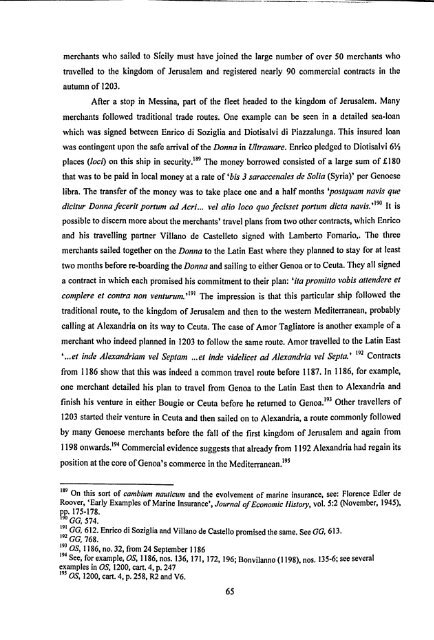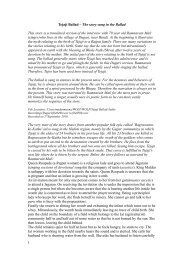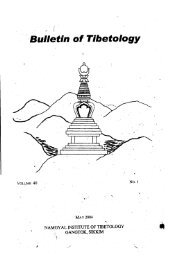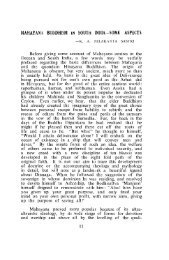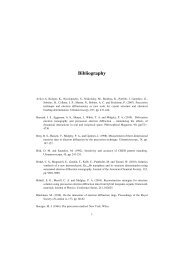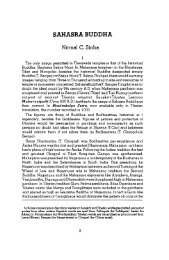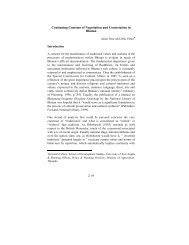The Crusades, the Genoese and the Latin East - DSpace at ...
The Crusades, the Genoese and the Latin East - DSpace at ...
The Crusades, the Genoese and the Latin East - DSpace at ...
You also want an ePaper? Increase the reach of your titles
YUMPU automatically turns print PDFs into web optimized ePapers that Google loves.
merchants who sailed to Sicily must have joined <strong>the</strong> large number of over 50 merchants who<br />
travelled to <strong>the</strong> kingdom of Jerusalem <strong>and</strong> registered nearly 90 commercial contracts in <strong>the</strong><br />
autumn of 1203.<br />
After a stop in Messina, part of <strong>the</strong> fleet headed to <strong>the</strong> kingdom of Jerusalem. Many<br />
merchants followed traditional trade routes. One example can be seen in a detailed sea-loan<br />
which was signed between Enrico di Soziglia <strong>and</strong> Diotisalvi di Piazzalunga. This insured loan<br />
was contingent upon <strong>the</strong> safe arrival of <strong>the</strong> Donna in Ultramare. Enrico pledged to Diotisalvi 6/2<br />
places (loci) on this ship in security. 189<br />
<strong>The</strong> money borrowed consisted of a large sum of £180<br />
th<strong>at</strong> was to be paid in local money <strong>at</strong> a r<strong>at</strong>e of 'bis 3 saraccenales de Solia (Syria)' per <strong>Genoese</strong><br />
libra. <strong>The</strong> transfer of <strong>the</strong> money was to take place one <strong>and</strong> a half months `postquam navis que<br />
dicitur Donna fecerit portum ad Acri... vel alio loco quo fecisset portum dicta navis. '190 It is<br />
possible to discern more about <strong>the</strong> merchants' travel plans from two o<strong>the</strong>r contracts, which Enrico<br />
<strong>and</strong> his travelling partner Villano de Castelleto signed with Lamberto Fornario,. <strong>The</strong> three<br />
merchants sailed toge<strong>the</strong>r on <strong>the</strong> Donna to <strong>the</strong> <strong>L<strong>at</strong>in</strong> <strong>East</strong> where <strong>the</strong>y planned to stay for <strong>at</strong> least<br />
two months before re-boarding <strong>the</strong> Donna <strong>and</strong> sailing to ei<strong>the</strong>r Genoa or to Ceuta. <strong>The</strong>y all signed<br />
a contract in which each promised his commitment to <strong>the</strong>ir plan: `ita promitto vobis <strong>at</strong>tendere et<br />
complere et contra non venturum. '191 <strong>The</strong> impression is th<strong>at</strong> this particular ship followed <strong>the</strong><br />
traditional route, to <strong>the</strong> kingdom of Jerusalem <strong>and</strong> <strong>the</strong>n to <strong>the</strong> western Mediterranean, probably<br />
calling <strong>at</strong> Alex<strong>and</strong>ria on its way to Ceuta. <strong>The</strong> case of Amor Tagli<strong>at</strong>ore is ano<strong>the</strong>r example of a<br />
merchant who indeed planned in 1203 to follow <strong>the</strong> same route. Amor travelled to <strong>the</strong> <strong>L<strong>at</strong>in</strong> <strong>East</strong><br />
`... et inde Alex<strong>and</strong>riam vel Septam<br />
... et inde videlicet ad Alex<strong>and</strong>ria vel Septa. ' 192 Contracts<br />
from 1 186 show th<strong>at</strong> this was indeed a common travel route before 1187. In 1186, for example,<br />
one merchant detailed his plan to travel from Genoa to <strong>the</strong> <strong>L<strong>at</strong>in</strong> <strong>East</strong> <strong>the</strong>n to Alex<strong>and</strong>ria <strong>and</strong><br />
finish his venture in ei<strong>the</strong>r Bougie or Ceuta before he returned to Genoa. 193 O<strong>the</strong>r travellers of<br />
1203 started <strong>the</strong>ir venture in Ceuta <strong>and</strong> <strong>the</strong>n sailed on to Alex<strong>and</strong>ria, a route commonly followed<br />
by many <strong>Genoese</strong> merchants before <strong>the</strong> fall of <strong>the</strong> first kingdom of Jerusalem <strong>and</strong> again from<br />
1198 onwards. 194 Commercial evidence suggests th<strong>at</strong> already from 1192 Alex<strong>and</strong>ria had regain its<br />
position <strong>at</strong> <strong>the</strong> core of Genoa's commerce in <strong>the</strong> Mediterranean. 195<br />
189 On this sort of cambium nauticum <strong>and</strong> <strong>the</strong> evolvement of marine insurance, see: Florence Edler de<br />
Roover, `Early Examples of Marine Insurance', Journal of Economic History, vol. 5: 2 (November, 1945),<br />
pp. 175-178.<br />
90 GG, 574.<br />
191 GG, 612. Enrico di Soziglia <strong>and</strong> Villano de Castello promised <strong>the</strong> same. See GG, 613.<br />
'92 GG, 768.<br />
193 OS, 1186, no. 32, from 24 September 1186<br />
194 See, for example, OS, 1186, nos. 136,171,172,196; Bonvilanno (1198), nos. 135-6; see several<br />
examples in OS, 1200, cart. 4, p. 247<br />
195<br />
OS, 1200, cart. 4, p. 258, R2 <strong>and</strong> V6.<br />
65


